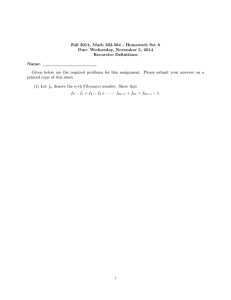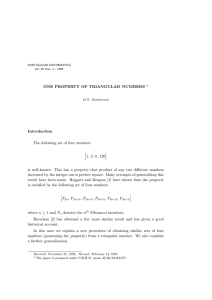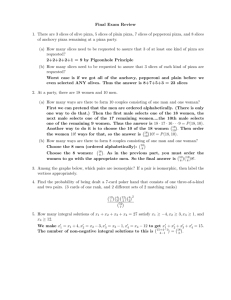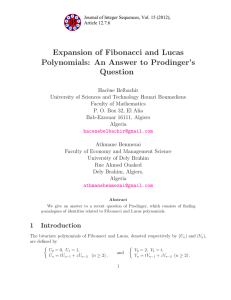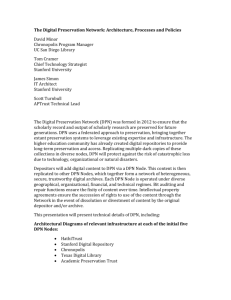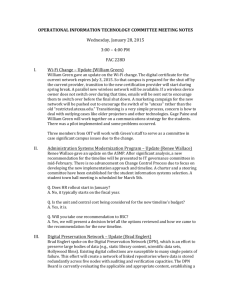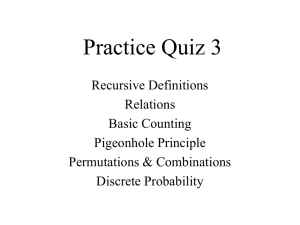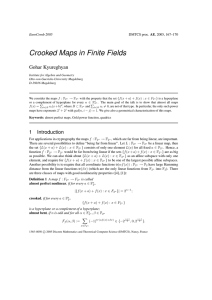ELEMENTARY PROBLEMS AND SOLUTIONS
advertisement
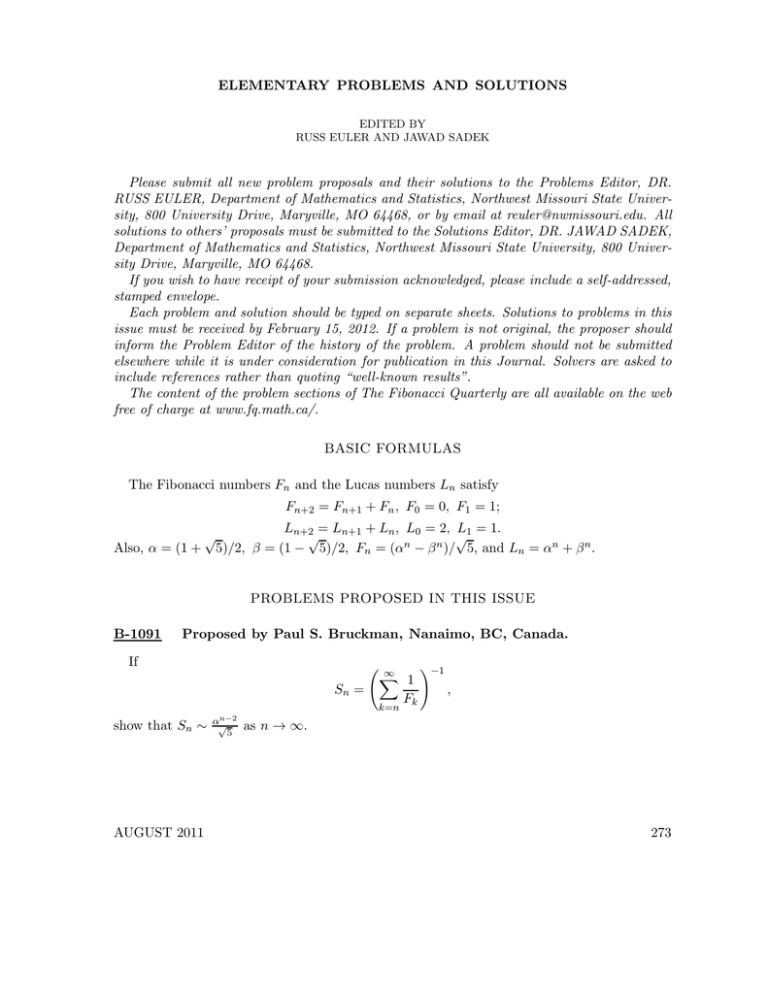
ELEMENTARY PROBLEMS AND SOLUTIONS
EDITED BY
RUSS EULER AND JAWAD SADEK
Please submit all new problem proposals and their solutions to the Problems Editor, DR.
RUSS EULER, Department of Mathematics and Statistics, Northwest Missouri State University, 800 University Drive, Maryville, MO 64468, or by email at reuler@nwmissouri.edu. All
solutions to others’ proposals must be submitted to the Solutions Editor, DR. JAWAD SADEK,
Department of Mathematics and Statistics, Northwest Missouri State University, 800 University Drive, Maryville, MO 64468.
If you wish to have receipt of your submission acknowledged, please include a self-addressed,
stamped envelope.
Each problem and solution should be typed on separate sheets. Solutions to problems in this
issue must be received by February 15, 2012. If a problem is not original, the proposer should
inform the Problem Editor of the history of the problem. A problem should not be submitted
elsewhere while it is under consideration for publication in this Journal. Solvers are asked to
include references rather than quoting “well-known results”.
The content of the problem sections of The Fibonacci Quarterly are all available on the web
free of charge at www.fq.math.ca/.
BASIC FORMULAS
The Fibonacci numbers Fn and the Lucas numbers Ln satisfy
Fn+2 = Fn+1 + Fn , F0 = 0, F1 = 1;
Ln+2 = Ln+1 + Ln , L0 = 2, L1 = 1.
√
√
√
Also, α = (1 + 5)/2, β = (1 − 5)/2, Fn = (αn − β n )/ 5, and Ln = αn + β n .
PROBLEMS PROPOSED IN THIS ISSUE
B-1091
Proposed by Paul S. Bruckman, Nanaimo, BC, Canada.
If
Sn =
∞
X
1
Fk
k=n
show that Sn ∼
AUGUST 2011
n−2
α√
5
as n → ∞.
!−1
,
273
THE FIBONACCI QUARTERLY
B-1092
Proposed by José Luis Dı́az-Barrero, Technical University of Catalonia,
Barcelona, Spain.
Compute the sum
∞
X
n=0
B-1093
n
X Fk+1 Fn−k+1
1
.
(5α)n (n + 2)
k+1
k=0
Proposed by Paul S. Bruckman, Nanaimo, BC, Canada.
Prove the following identity:
[n/3]
X
(−1)k
k=0
B-1094
n − 2k n−3k
2
= Fn+3 − 1.
k
Proposed by Paul S. Bruckman, Nanaimo, BC, Canada.
Prove the following identity:
[n/3] X
k=0
B-1095
n − k n−3k
2
= F2n + 1.
2k
Proposed by Sergio Falcón and Ángel Plaza, Universidad de Las Palmas
de Gran Canaria, Spain.
For any positive integer k, the k-Fibonacci sequence, say {Fk,n }n∈N is defined recurrently
by Fk,n+1 = kFk,n + Fk,n−1 for n ≥ 1, with
initial conditions
Fk,0 = 0; Fk,1 = 1. Let {an,j } be
n
n
n the integer matrix defined by an,j = j − k j+1 − j+2 . Prove that
n
X
an,j Fk,j+1 = 1.
j=0
274
VOLUME 49, NUMBER 3
ELEMENTARY PROBLEMS AND SOLUTIONS
SOLUTIONS
Higher Powers Equalities
B-1071
Proposed by Hideyuki Ohtsuka, Saitama, Japan
(Vol. 48.3, August 2010)
Prove the following identities:
4
4
4
2
(1) Fn−1
+ 4Fn4 + 4Fn+1
+ Fn+2
= 6F2n+1
,
6
6
6
3
(2) Fn−1
+ 8Fn6 + 8Fn+1
+ Fn+2
= 10F2n+1
.
Solution I by Paul S. Bruckman, 38 Front St., Unit #302, Nanaimo, BC V9R 0B8
Canada and (separately) by Sergio Falcón and Ángel Plaza (jointly), Department
of Mathematics, Universidad de Las Palmas de Gran Canaria, Las Palmas G. C.,
Spain.
The proposed identities appear in a slightly altered form in the following reference:
References
[1] R. S. Melham, On certain combinations of high powers of Fibonacci numbers, The Fibonacci Quarterly,
48.3 (2010), 256–259.
If we replace n by n − 1 in Equations (1.4) and (1.8) of [1], we obtain the desired identities.
Solution II by Zbigniew Jakubczyk, Warsaw, Poland
We can easily prove the identity:
(a − b)4 + 4a4 + 4b4 + (a + b)4 = 6(a2 + b2 )2 .
Let b = Fn , a = Fn+1 . Since
Fn−1 = Fn+1 − Fn = a − b
Fn+2 = Fn+1 + Fn = a + b
2
F2n+1 = Fn2 + Fn+1
= a2 + b2 ,
we get identity (1). Identity (2) follows from the identity:
(a − b)6 + 8a6 + 8b6 + (a + b)6 = 10(a2 + b2 )3
in a similar fashion.
Also solved by Charles K. Cook, Russell J. Hendel, George A. Hisert, Seung Hee
Lee (student), Jaroslav Seibert, and the proposer.
Weighted Averages Type Inequality
B-1072
Proposed by José Luis Dı́az-Barrero, Universidad Politécnica de Cataluña,
Barcelona, Spain
(Vol. 48.3, August 2010)
AUGUST 2011
275
THE FIBONACCI QUARTERLY
Let n be a positive integer. For any real number, γ > 1, show that
n
1 X 2γ 2(1−γ)
+ (γ − 1)L2k ≥ Fn Fn+1 .
Fk Lk
γ
k=1
Solution by Hideyuki Ohtsuka, Saitama, Japan
Using Bernoulli’s inequality, we have
2
γ1
Fk
Fk2
1+
−
1
γ
≤
.
L2k
L2k
Therefore, we obtain the inequality
(1−γ)
Fk2γ L2k
+ (γ − 1)L2k − γFk2 ≥ 0.
P
Using this inequality and the identity nk=1 Fk2 = Fn Fn+1 , we get
n
n
X
X
2(1−γ)
2γ 2(1−γ)
2
2
0≤
(Fk Lk
+ (γ − 1)Lk − γFk ) =
(Fk2γ Lk
+ (γ − 1)L2k ) − γFn Fn+1 .
k=1
k=1
The desired inequality follows.
Also solved by Paul S. Bruckman, Zbigniew Jakubczyk, Jaroslav Seibert, and the
proposer.
A Diophantine Triple in Fibonacci Numbers
B-1073
Proposed by M. N. Deshpande, Nagpur, India
(Vol. 48.3, August 2010)
Three integers (a, b, c) form a Diophantine Triple (DT) if and only if ab + 1, ac + 1, and
bc + 1 are perfect squares. It is known that (F2n , F2n+2 , F2n+4 ) is a DT for every integer n.
If n is odd, prove that there exists an integer m such that (m − F2n+4 , m − F2n+2 , m − F2n )
is a DT. Also, if n = 2k + 1 and the corresponding m is denoted by mk , derive a recurrence
relation involving mk .
Solution by Brian P. Beasley, Department of Mathematics, Presbyterian College,
Clinton, SC
For k ≥ 0, we let n = 2k + 1 and define mk+2 = 7m
√k+1 − mk with m0 = √8 and
m1 = 56. pThen mk = Cα4k + Dβ 4k , where C p
= 4 + 28 5/15 and D = 4 − 28 5/15.
Let
p xk = (mk − F2n+4 )(mk − F2n+2 ) + 1, yk = (mk − F2n+4 )(mk − F2n ) + 1, and zk =
(mk − F2n+2 )(mk − F2n ) + 1. Then
√ !
√ !
5
5
7
7
2
2
8k
xk =
+
α +
−
β 8k + ,
18
6
18
6
9
√
√
so xk = (1/2 + 5/6)α4k + (1/2 − 5/6)β 4k . Similarly, we note that
√ !
√ !
1 7 5
1
7
5
yk =
+
α4k +
−
β 4k
2
30
2
30
276
VOLUME 49, NUMBER 3
ELEMENTARY PROBLEMS AND SOLUTIONS
and
zk =
√ !
4 5
α4k +
3+
3
√ !
4 5
β 4k .
3−
3
These sequences satisfy the following recurrence relations: x0 = 1, x1 = 6, xk+2 = 7xk+1 − xk ;
y0 = 1, y1 = 7, yk+2 = 7yk+1 − yk ; z0 = 6, z1 = 41, zk+2 = 7zk+1 − zk . (In fact, mk = 8yk and
zk = xk+1 .) Hence, xk , yk , and zk are integers for every k, so (mk −F2k+4 , mk −F2n+2 , mk −F2n )
is a DT.
We note that when k = 0, the DT is (0, 5, 7); for k > 0, each element in the DT is positive.
If negative integers are allowed in a DT, then m = 0 produces a trivial solution to the original
problem. There is no recurrence involving m in this case.
Also solved by Paul S. Bruckman, Charles K. Cook, Russell J. Hendel, and the
proposer.
A HM-GM Inequality Application
B-1074
Proposed by Pantelimon George Popescu, Bucureşt, România and José
Luis Dı́az-Barrero, Universidad Politécnica de Cataloñia, Barcelona, Spain
(Vol. 48.3, August 2010)
Let n ≥ 3 be a positive integer. Prove that
1
q
1−
1
Fn2
+q
1
1−
1
L2n
>r
1−
2
Fn+1
F2n
2 .
Solution by ONU-Solve problem group, Department of Mathematics and Statistics, ONU, Ada, OH
If n ≥ 3, the harmonic-quadratic mean inequality gives
v
2 q
2 s
u q
u
1
1
1
−
+
1
−
t
2
2
Fn
Ln
2
1 1
1
<
= 1−
+
.
q 1
2
2 Fn2 L2n
+q 1 1
1
1−
2
Fn
1−
(1)
L2
n
Note that the inequality in (1) is strict since Fn 6= Ln . Indeed, Ln = Fn+1 + Fn−1 > Fn for
n ≥ 2. Next, we will show that
2
Fn+1
1 1
1
+
>
(2)
2
2 Fn2 L2n
F2n
holds for n ≥ 2. Indeed, if we use F2n = Fn Ln , we see that (2) is equivalent to
2
Fn2 + L2n > 2Fn+1
,
(3)
and if we further use the identity 2Fn+1 = Fn + Ln , we see that (3) is equivalent to
2Fn2 + 2L2n > (Fn + Ln )2 ,
AUGUST 2011
(4)
277
THE FIBONACCI QUARTERLY
or (Fn − Ln )2 > 0, which holds for all n ≥ 2 since Fn 6= Ln . Finally, if n ≥ 3, from (1) and (2)
we obtain
s
Fn+1 2
2
< 1−
,
q 1
F2n
+q 1 1
1
1−
or
which is the desired result.
2
Fn
1
q
1−
1
Fn2
1−
L2
n
1
+q
1−
1
L2n
>r
1−
2
Fn+1
F2n
2
Also solved by Paul S. Bruckman, Russell J. Hendel, Zbigniew Jakubczyk, and
the proposer.
278
VOLUME 49, NUMBER 3
ELEMENTARY PROBLEMS AND SOLUTIONS
An “Inverse” Relation
B-1075
Proposed by Paul S. Bruckman, Nanaimo, BC, Canada
(Vol. 48.3, August 2010)
The Fibonacci polynomials Fn (x) may be defined by the following expression:
[n/2] X n − k
Fn+1 (x) =
xn−2k for n = 0, 1, 2, . . . .
k
k=0
Prove the “inverse” relation:
n
X
n
k n
x =
(−1)
Fn+1−2k (x) for n = 0, 1, 2, . . . .
k
k=0
No solutions, other than the proposer’s, were received for this problem. The deadline will be
extended another three months.
A Closed Form For a Finite Product
B-1076
Proposed by Hideyuki Ohtsuka, Saitama, Japan
(Vol. 48.3, November 2010)
Find the closed form expression for
n
Y
(L2k+1 − L2k + 1).
k=1
Solution by Paul S. Bruckman, Nanaimo, BC, Canada
Let Pn denote the indicated product, n = 1, 2, . . .. Write m = m(k) = 2k , for brevity. Then
Pn =
=
=
=
n
Y
(L2m − Lm + 1) =
k=1
n
Y
(L2m − Lm − 1) =
k=1
n
Y
(Lm − α)(Lm − β)
k=1
(αm − α + α−m )(αm − β + α−m )
k=1
n
Y
(α2m − αm + 1 − α−m + α−2m )
k=1
n
Y
k=1
n−1
Y
=5
k=1
AUGUST 2011
n
Y
α5m/2 + α−5m/2
αm/2 + α−m/2
!
=
α5 − β 5
α−β
n−1
Y
k=1
α5m + β 5m
αm − β m
L5m
.
Lm
279
THE FIBONACCI QUARTERLY
Now,
F2 L2 L4 . . . L2n−1 = F4 L4 . . . L2n−1 = F8 . . . L2n−1 = . . . = F2n .
Likewise,
F10 L10 L20 . . . L5·2n−1 = F20 . . . L5·2n−1 = F40 . . . L5·2n−1 = . . . = F5·2n .
Then,
5F2 F5·2n
F5·2n
·
=
, n = 1, 2, . . . ,
F10 F2n
11F2n
which is the desired closed form. Note that
F10
F20
55 · 123
P1 =
=
= 5; P2 =
= 5 · 41 = 205;
11
11F4
11 · 3
F40
55 · 123 · 15127
P3 =
=
= 5 · 41 · 2161 = 443005;
11F8
11 · 3 · 7
etc.
Pn =
Also solved by the proposer.
280
VOLUME 49, NUMBER 3
